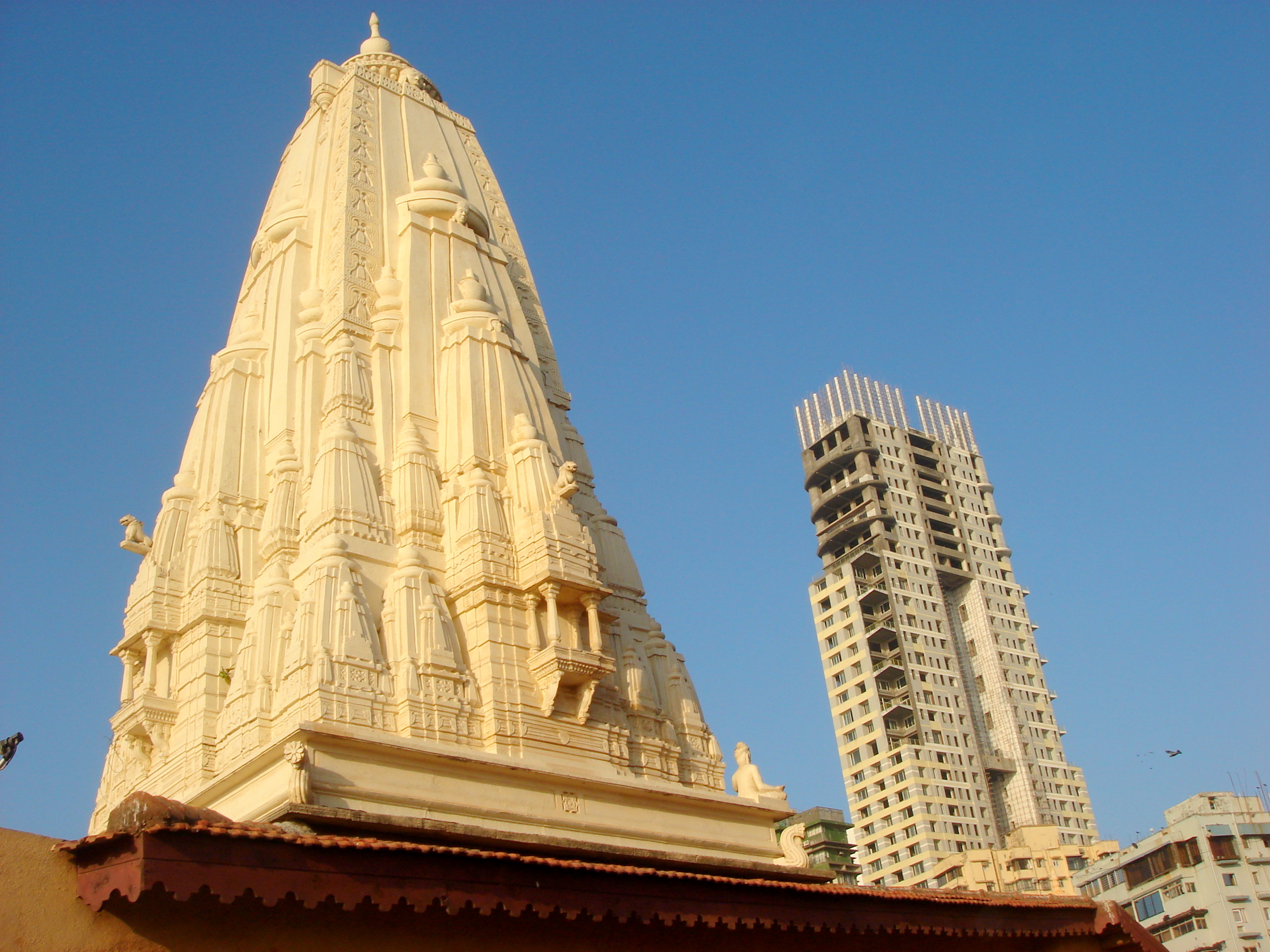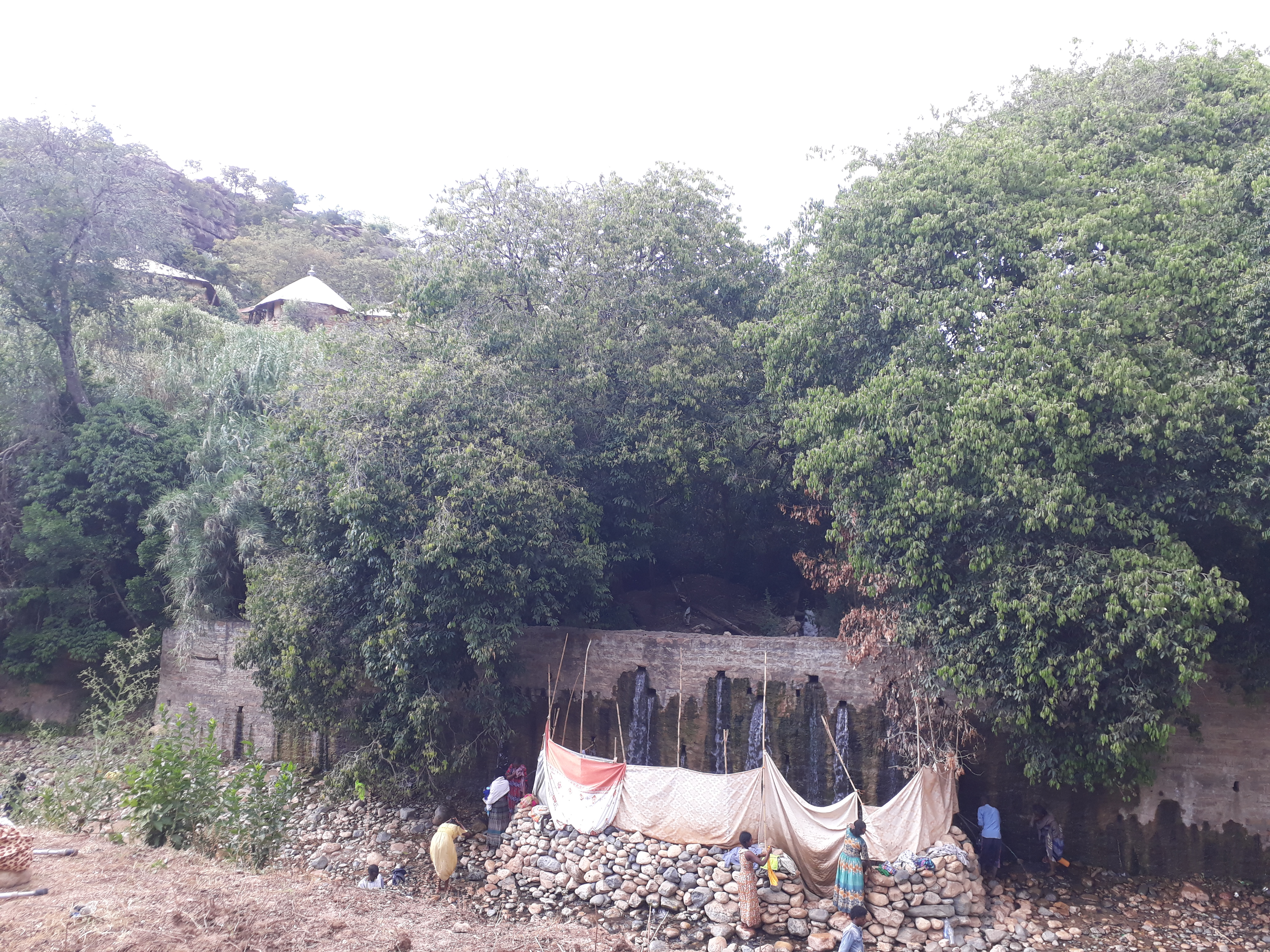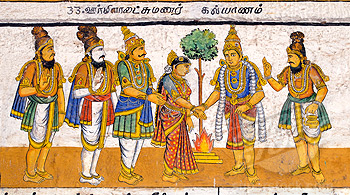|
Baanganga
Baanganga (Sanskrit: बाणगंगा ) generally refers to the legendary ponds or rivers in the Indian subcontinent which had been created by shooting some divine arrows into the ground. These are tied to some legends of deities or divine figures in Hinduism shooting an arrow into the ground, resulting in the emergence of water that is considered as sacred as the Ganges River. According to legendary stories, there are several ''Bangangas'' in the different parts of the Indian subcontinent. Etymology Baanganga is a Sanskrit word. It is the combination of the two Sanskrit terms ''Baan'' and ''Ganga''. The literal meaning of the term Baan is an arrow. The term Ganga in Hinduism is used for denoting sacred water or the Ganga river. Thus the literal meaning of the combined term Baanganga is a sacred water body pierced by of an arrow. Description One of the important ''Bangangas'' in the epic Mahabharata is located at Kurukshetra. It is related to the war of Mahabharata at t ... [...More Info...] [...Related Items...] OR: [Wikipedia] [Google] [Baidu] |
Walkeshwar Temple
Walkeshwar Temple, also known as the (Baan Ganga Temple), is an Ancient Hindu temple, dedicated to Lord Shiva located in Walkeshwar, near Malabar Hill neighbourhood, in South Mumbai precinct of the city of Mumbai, India. It is situated at the highest point of the city, and close to the temple lies the Banganga Tank. Legend Legend has it that Hindu god, Rama paused at that spot on his way from Ayodhya to Lanka in pursuit of the demon king, Ravana who had kidnapped his wife, Sita. Then Lord Rama was advised to worship Shiva lingam and he is said to have constructed the original linga of sand, after getting tired of waiting for his brother, Lakshman to bring an idol. The name is etymologically derived from the Sanskrit word for an idol made of sand -- '' Valuka Iswar'', an Avatar of Shiva. As the story progresses, when Rama was thirsty, as there was no fresh water readily available (only sea water), he shot an arrow and brought Ganges over here. Hence ''Bana'' (arrow in Sa ... [...More Info...] [...Related Items...] OR: [Wikipedia] [Google] [Baidu] |
Banganga Tank
The Banganga Tank is a temple tank which is part of the Hindu Walkeshwar Temple complex in the Malabar Hill area of the city of Mumbai, India. History The tank was built in AD 1127 by Lakshman Prabhu, a minister in the court of Silhara kings of Thane. It was rebuilt in 1715, funded by a donation from Rama Kamath. The main temple has since been reconstructed and is now a reinforced concrete structure of recent construction. Banganga in mythology According to local legend, the temple sprang forth when Rama, the exiled hero of the epic ''Ramayana'', stopped at the spot in search of his kidnapped wife, Sita. As the legend goes, overcome with fatigue and thirst, Rama asked his brother Lakshmana to bring him some water. Lakshmana instantly shot an arrow into the ground, and water gushed forth from the ground, creating a tributary of the Ganges, which flows over a thousand miles away – hence its name, ''Banganga'', ie the ''Ganga'' created by a ''baan'' (arrow). The Bangang ... [...More Info...] [...Related Items...] OR: [Wikipedia] [Google] [Baidu] |
Baneshwar Sthan
Baneshwar Sthan ( Maithili: बाणेश्वर स्थान) is an ancient place believed to be related to the epic Mahabharata in the Mithila region of Bihar in India. It is located at ''Barri'' village of the Benipatti block in the Madhubani district of Bihar. There is a temple of Lord Shiva known as ''Baneshwar Nath Mahadev Mandir''. Description Baneshwar Sthan is a Hindu pilgrimage site at Barri village of the Madhubani district in Mithila region of Bihar. According to local legends, it is associated with the epic Mahabharata. There is a devine pond known as ''Banganga'' at the religious site ''Baneshwar Sthan''. On the bank of the devine pond Banganga, there is an ancient Lord Shiva temple known as ''Baneshwar Nath Mahadev Mandir.'' According to the believes of the local residents, it is said that ''Baba Baidyanath'' resides at this place for one and a quarter hours''.'' There is a big plot spread over approximately 85 '' bighas'' of land. Legend There is local l ... [...More Info...] [...Related Items...] OR: [Wikipedia] [Google] [Baidu] |
Ajnatavasa
Ajnatavasa (Sanskrit: अज्ञातवास, ''ajñātavāsa'', lit. "living in obscurity" or "unknown abode") refers to the thirteenth year of exile undertaken by the Pandavas, the protagonists of the Hindu epic ''Mahabharata''. This period, detailed in The Book of Virata (''Virata Parva''), required the five Pandava brothers—Yudhishthira, Bhima, Arjuna, Nakula, and Sahadeva—along with their wife Draupadi, to live incognito after spending twelve years in forest exile. The condition, stipulated after Yudhishthira’s loss in a game of dice against the Kauravas, mandated that they remain unrecognized in a populated area; if discovered, they would face an additional twelve years of exile. Background The Pandavas—Yudhishthira, Bhima, Arjuna, Nakula, and Sahadeva—along with their wife, Draupadi, were exiled after losing a rigged dice game to the Kauravas in the ''Sabha Parva'' (The Book of the Assembly Hall). As per the agreement, they had to endure twelve years in the fo ... [...More Info...] [...Related Items...] OR: [Wikipedia] [Google] [Baidu] |
Puranas
Puranas (Merriam-Webster's Encyclopedia of Literature (1995 Edition), Article on "Puranas", , page 915) are a vast genre of Indian literature that include a wide range of topics, especially legends and other traditional lore. The Puranas are known for the intricate layers of symbolism depicted within their stories. Composed originally in Sanskrit and in Languages of India, other Indian languages,John Cort (1993), "An Overview of the Jaina Puranas" in ''Purana Perennis: Reciprocity and Transformation in Hindu and Jaina Texts,'' (Editor: Wendy Doniger), State University of New York Press, , pages 185-204 several of these texts are named after major Hindu deities such as Vishnu, Shiva, Brahma, and Mahadevi, Devi. The Puranic genre of literat ... [...More Info...] [...Related Items...] OR: [Wikipedia] [Google] [Baidu] |
Mahabharata
The ''Mahābhārata'' ( ; , , ) is one of the two major Sanskrit Indian epic poetry, epics of ancient India revered as Smriti texts in Hinduism, the other being the ''Ramayana, Rāmāyaṇa''. It narrates the events and aftermath of the Kurukshetra War, a war of succession between two groups of princely cousins, the Kauravas and the Pandava, Pāṇḍavas. It also contains Hindu philosophy, philosophical and devotional material, such as a discussion of the four "goals of life" or ''puruṣārtha'' (12.161). Among the principal works and stories in the ''Mahābhārata'' are the ''Bhagavad Gita'', the story of Damayanti, the story of Shakuntala, the story of Pururava and Urvashi, the story of Savitri and Satyavan, the story of Kacha (sage), Kacha and Devayani, the story of Rishyasringa and an Ramopakhyana, abbreviated version of the ''Rāmāyaṇa'', often considered as works in their own right. Traditionally, the authorship of the ''Mahābhārata'' is attributed to Vyasa, Vy ... [...More Info...] [...Related Items...] OR: [Wikipedia] [Google] [Baidu] |
Water And Religion
Water is considered a Ritual purification, purifier in most religions. Holy water Some faiths use water especially prepared for religious purposes (holy water in most Christian denominations, ''mambuha'' in Mandaeism, ''amrita'' in Sikhism and Hinduism). Many religions also consider particular sources or bodies of water to be sacred or at least auspicious; examples include Lourdes in Roman Catholicism, the Jordan River (at least symbolically) in some Christian churches and Mandaeism called yardna, ''Yardena'', the Zamzam Well in Islam and the River Ganges (among many others) in Hinduism. Ritual washing Faiths that incorporate ritual washing (Ritual purification, ablution) include Christianity, Mandaeism, Hinduism, Buddhism, Sikhism, Judaism, Islam, the Baháʼí Faith, Shinto, Taoism, and the Rastafari movement. Immersion (or aspersion or affusion) of a person in water is a central sacrament of Christianity (where it is called baptism); it is also a part of the practice of oth ... [...More Info...] [...Related Items...] OR: [Wikipedia] [Google] [Baidu] |
Ganga (goddess)
Ganga (, ) is the personification of the river Ganges, who is worshipped by Hindus as the goddess of purification and forgiveness. Known by many names, Ganga is often depicted as a fair, beautiful woman, riding a divine crocodile-like creature called the makara. Some of the earliest mentions of Ganga are found in the Rigveda, where she is mentioned as the holiest of the rivers. Her stories mainly appear in post-Vedic texts such as the ''Ramayana'', ''Mahabharata,'' and the ''Puranas''. The ''Ramayana'' describes her to be the firstborn of Himavat, the personification of the Himalayas, and the sister of the mother goddess Parvati. However, other texts mention her origin from the preserver deity, Vishnu. Legends focus on her descent to earth, which occurred because of a royal-sage Bhagiratha, aided by the god Shiva. In the epic ''Mahabharata'', Ganga is the mother of the warrior Bhishma in a union with the Kuru Kingdom, Kuru king Shantanu. In Hinduism, Ganga is seen as a moth ... [...More Info...] [...Related Items...] OR: [Wikipedia] [Google] [Baidu] |
Lakshmana
Lakshmana (, ), also known as Laxmana, Lakhan, Saumitra, and Ramanuja, is the younger brother of Rama in the Hindu epic ''Ramayana''. He is considered as an incarnation of Shesha, the lord of serpents. Lakshmana was married to Urmila, and is known for his loyalty and dedication towards Rama. Lakshmana was born to King Dasharatha of Ayodhya and Queen Sumitra. Shatrughna, is his twin brother. He was married to Urmila, after his brother Rama married Sita in her swayamvara. Lakshmana devoted himself to Rama since childhood and accompanied him during his fourteen-year exile, serving him and Sita endlessly. He also played a pivotal role in the war and killed Meghanada. Lakshmana is worshipped in Hinduism, at various places in India, alongside Rama and Sita. Etymology The name Lakshmana is of Sanskrit origin, which means 'the one endowed with auspicious signs'. He bears the epithets of Saumitra (, ) and Ramanuja (, ). Legend Birth and early life King Dasharatha of A ... [...More Info...] [...Related Items...] OR: [Wikipedia] [Google] [Baidu] |
Rama
Rama (; , , ) is a major deity in Hinduism. He is worshipped as the seventh and one of the most popular avatars of Vishnu. In Rama-centric Hindu traditions, he is considered the Supreme Being. Also considered as the ideal man (''maryāda'' ''puruṣottama''), Rama is the male protagonist of the Hindu epic '' Ramayana''. His birth is celebrated every year on Rama Navami, which falls on the ninth day of the bright half ( Shukla Paksha) of the lunar cycle of Chaitra (March–April), the first month in the Hindu calendar. According to the ''Ramayana'', Rama was born to Dasaratha and his first wife Kausalya in Ayodhya, the capital of the Kingdom of Kosala. His siblings included Lakshmana, Bharata, and Shatrughna. He married Sita. Born in a royal family, Rama's life is described in the Hindu texts as one challenged by unexpected changes, such as an exile into impoverished and difficult circumstances, and challenges of ethical questions and moral dilemmas. The most not ... [...More Info...] [...Related Items...] OR: [Wikipedia] [Google] [Baidu] |
Ravana
According to the Mahakavya, Hindu epic, ''Ramayana'', Ravana was a kingJustin W. Henry, ''Ravana's Kingdom: The Ramayana and Sri Lankan History from Below'', Oxford University Press, p.3 of the island of Lanka, in which he is the chief antagonist and is considered to be a Rakshasa (demon). In the ''Ramayana'', Ravana is described as the eldest son of sage Vishrava and Kaikesi, Kaikasi. He abducted Rama's wife, Sita, and took her to his kingdom of Lanka, where he held her in the Ashok Vatika, Ashoka Vatika. Rama, with the support of vanara King Sugriva and his army of vanaras, launched a rescue operation for Sita against Ravana in Lanka. Ravana was subsequently slain, and Rama rescued his beloved wife Sita. Ravana was well-versed in the six shastras and the four Vedas, including the Shiva Tandava Stotra. Ravana is also considered to be the most revered devotee of Shiva. Images of Ravana are often seen associated with Shiva at temples. He also appears in the Buddhist Mahayana t ... [...More Info...] [...Related Items...] OR: [Wikipedia] [Google] [Baidu] |









